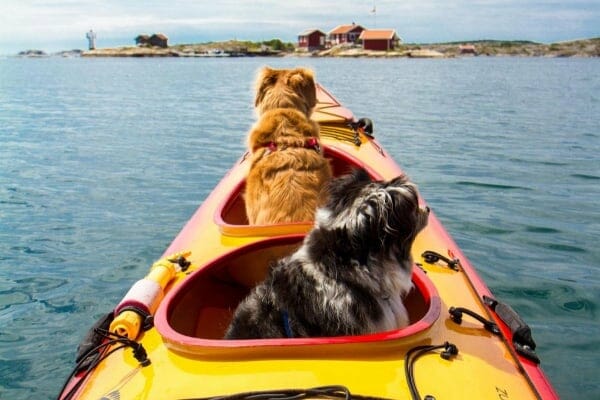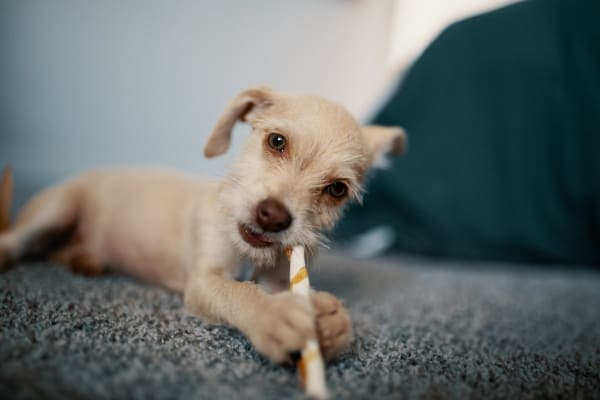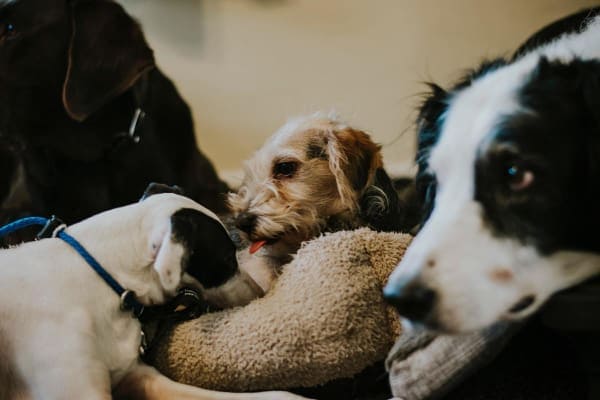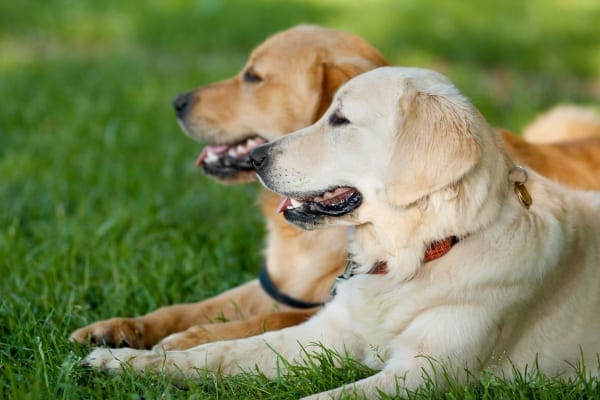
You love your older dog to pieces and want to give him all the care, treats, and belly rubs he deserves. So how do you care well for your older dog when a new puppy joins the family? In today’s post, Dr. Julie Buzby, integrative veterinarian and founder of Dr. Buzby’s ToeGrips®, welcomes Dr. Ericka Mendez to the blog to wisely guide you through this exciting, but delicate, family transition. Dr. Mendez, a fellow veterinarian with a special interest in small animal behavior and counseling, provides five tips for successfully introducing your new puppy to your older dog. Her thoughts are sure to be a vital resource as you welcome a playful pup into your furry fold.
As a veterinarian, I’m always happy to see a new puppy enter a family’s life. It can rejuvenate an older dog, provide a much-needed playmate for a young dog, and offer comfort and solace to a dog that just lost his lifelong buddy.
Many people wonder how their older dog will feel when a new puppy comes along:
- Will he be jealous or get depressed?
- Will the new puppy irritate him?
- Is he too old to adjust to a new puppy?
And while there is no one-size-fits-all answer, as a veterinarian and dog trainer, I can tell you when done correctly, most dogs thrive in the company of a new puppy.
A word of wisdom about older dogs and new puppies
If your older dog is facing the final stages of a fatal disease or has severe mobility issues, it may be wise to devote your time to your older dog rather than redirecting your attention toward a new puppy — at least temporarily.
With some forethought and guidance, you can prevent difficulties like jealousy and depression and set the stage for your older dog, and new puppy, to build a positive and rewarding friendship.
Ready to get started? Here are my top five tips for how to introduce your new puppy to your older dog.
1. Prepare your home for a new puppy.
Before welcoming your puppy, be sure to puppy-proof your home. An easy way to do this is to get down on the floor at puppy level and have a look around.
- Remove anything that would be dangerous for the puppy to chew, and put baskets, books, and shoes out of reach.
- Gather all of the dog toys scattered about the house. Don’t forget to look under the furniture, too! Now, it’s time to sort.
- Throw away any toys that have ears, eyes, or strings that can be torn off or swallowed.
- Take any toys that are your older dogs’ favorites, and move those to a high shelf for safekeeping.
- Put away valuable chewables such as bully sticks, rawhides, or chew bones. Special toys and chews can be offered to your older dog while your puppy is confined.

Bonus tip: Until you have a better understanding of how your older dog will react to the new puppy around his favorite things, it is best to remove any potential sources of conflict.
For more on how to prepare your home and heart for a new puppy, read Dr. Buzby’s New Puppy Checklist: 6 Things Only a Veterinarian Will Tell You.
2. Create a long-term confinement area for your puppy.
Long-term confinement areas are a must when bringing a new puppy home, and even more so when there are other dogs in the house.
The long-term confinement area is where your puppy will spend his time when you’re away from home, when you’re unavailable to supervise the dogs together, and during feeding times. It provides a safe place for your puppy as your senior dog becomes acquainted with his newest family member.
This space can simply be a room or hallway with a baby gate or an exercise pen set up in the central area of your house. Make sure your confinement area includes:
- A comfortable bed
- Durable and safe chew toys
- A blanket-covered crate with the door propped open or removed. This gives the puppy an enclosed place to go when he feels uncertain or afraid. I call this a “puppy den.”
Bonus tip: If you’re leaving your puppy home longer than your established potty interval, include a potty area in the confinement space. Make sure to remove it, however, when you return home.
3. Arrange a safe and slow introduction.
First impressions are so important. A negative first interaction can take days to recover from — both for the new puppy and a fearful older dog.

To ensure a positive first impression, the safest thing to do is to introduce your older dog to your new puppy while the puppy is in his confinement area. This helps the puppy and older dog become comfortable with each other’s sights, smells, and sounds before interacting directly.
A new puppy can be very exciting for some older dogs, and in their excitement, they may overwhelm or frighten the puppy. Wait until the excitement of this new family member wears off before moving to the next step of the introduction.
For some dogs, this may happen in a day. For others, it may take several days. What’s important is to give both dogs time to adjust before allowing direct interaction.
4. Provide an escape route for both dogs.
Once your older dog has become accustomed to your puppy, and the new puppy is not showing any fear of the older dog, you can begin to let the dogs interact outside of the pen.
Choose a time when both dogs are calm and relaxed. It is best to keep these playtimes short at first, to ensure there are no indications of discomfort, fear, or aggression. Once everyone is enjoying a positive experience, you can let them interact for more extended periods.
During these interactions, it’s a good idea to have an escape route for your older dog and a place for your puppy to hide. This may be a couch your older dog can reach that your puppy can’t or a low barrier your older dog can walk over. For your puppy, his long-term confinement area will more than likely be his escape place.
With two escape routes, if your older dog has had enough, or your puppy is overwhelmed, each can leave the area without resorting to confrontational behaviors.
5. Watch for stress signals in your new puppy and older dog.
When introducing your older dog to your new puppy the first few times, it is important to understand how dogs communicate.
When puppies interact with older dogs, many display appeasement signals. These are the puppy’s way of attempting to put the older dog at ease. Appeasement signals include licking the older dogs’ muzzle, lifting a front paw, or showing his belly.
You also want to be aware of common stress signals that indicate your puppy or older dog is uncomfortable or annoyed.
These can be seen one at a time or in clusters. They include:
- freezing in place
- a stiff body posture
- looking away
- yawning
- repeatedly licking the lips or nose
- looking at the offender out of the corner of their eye
- frequently pulling away from the interaction
Intervene when you see these signals to prevent the interaction from escalating to growls or snaps.

If your older dog does growl or snap, avoid the impulse to correct him. Instead, see if you can identify the trigger. Ask yourself:
- Is there a favorite item nearby?
- Is there food around?
- Does my older dog need some space and quiet time?
Pay attention to the triggers and modify the environment to prevent it from happening again. Sometimes, your older dog needs shorter play periods and more alone time.
Bonus tip: If your older dog seems on edge around your puppy, it’s important to make sure he doesn’t have an underlying condition such as arthritis, back pain, chronic ear infections, or mouth pain, causing him to be less tolerant.
Best friends from the beginning
When you take the time to prepare your home for a new puppy and allow your dogs to get to know one another at their own pace, you’re taking a proactive and patient approach to assure your new puppy and your older dog start their friendship off on the right foot.

If after you’ve walked through these steps, your puppy or older dog is showing repeated signs of aggression, seek help from a qualified trainer or veterinarian.
A puppy should be a delightful addition to any family, and I’m confident with a little planning, that result is well within your reach. Congratulations, and enjoy your newest family member!
Have you recently introduced a puppy to your older dog — how did it go?
Share in the comments below — we’d love to hear!


We welcome your comments and questions about senior dog care.
However, if you need medical advice, diagnosis, or treatment, please contact your local veterinarian.